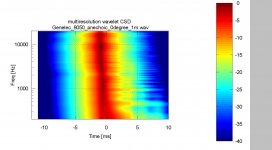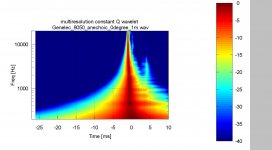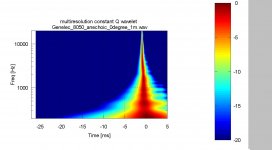Hello!
New updates to wavelet softwares:
http://dl.dropbox.com/u/2400456/html/Elias_Pekonen/main.html
go to wavelet software
Next planning to implement: multiresolution CSD, multiresolution constant Q, Bark, multiresolution Bark, Gammatone, multiresolution Gammatone, constant Q step ...
Sooo, at least don't run out of things to do.. 😀
- Elias
New updates to wavelet softwares:
http://dl.dropbox.com/u/2400456/html/Elias_Pekonen/main.html
go to wavelet software
Next planning to implement: multiresolution CSD, multiresolution constant Q, Bark, multiresolution Bark, Gammatone, multiresolution Gammatone, constant Q step ...
Sooo, at least don't run out of things to do.. 😀
- Elias
I've just started to play around with it, however, running 3.2.4 does not seem to be able to plot very well. It keeps refreshing. Is there anywhere 3.0.3 for windows can be downloaded? Running Win7 32 bit
Hi,
here's link for Octave 3.0.3 download packet for windows:
http://dl.dropbox.com/u/2400456/html/Elias_Pekonen/Wavelet Software.html
- Elias
here's link for Octave 3.0.3 download packet for windows:
http://dl.dropbox.com/u/2400456/html/Elias_Pekonen/Wavelet Software.html
- Elias
I've just started to play around with it, however, running 3.2.4 does not seem to be able to plot very well. It keeps refreshing. Is there anywhere 3.0.3 for windows can be downloaded? Running Win7 32 bit
I tried that, but could not figure out how to install it. 3.2.4 has a windows install execution file, but not 3.0.3
Hi,
There are old exceutables:
GNU Octave Repository - Browse /Octave_Windows - MinGW at SourceForge.net
Here is 3.0.3 executable installer:
Select GNU plot as graphic backend.
http://dl.dropbox.com/u/2400456/html/Elias_Pekonen/gnuoctave/octave-3.0.3-setup.exe
There are old exceutables:
GNU Octave Repository - Browse /Octave_Windows - MinGW at SourceForge.net
Here is 3.0.3 executable installer:
Select GNU plot as graphic backend.
http://dl.dropbox.com/u/2400456/html/Elias_Pekonen/gnuoctave/octave-3.0.3-setup.exe
I tried that, but could not figure out how to install it. 3.2.4 has a windows install execution file, but not 3.0.3
Hello !
Mega update of the wavelet analysis package !
See here for download and screen shots:
http://dl.dropbox.com/u/2400456/html/Elias_Pekonen/Wavelet_software.html
Features of the Wavelet Package:
* Wavelet analysis methods
o Wavelet CSD
o Constant Q Wavelet
o Bark Wavelet
o Multiresolution Wavelet CSD
o Multiresolution Constant Q Wavelet
o Multiresolution Bark Wavelet
* Supports mono WAV impulse response files
* User selectable parameters for wavelet analyses
o Frequency range
o Time range
o Amplitude scale dynamic range
o Amplitude absolute level
o Amplitude normalisation
o 3D plots
o and many wavelet specific parameters
Enjoy and report back ! 🙂
- Elias
Mega update of the wavelet analysis package !
See here for download and screen shots:
http://dl.dropbox.com/u/2400456/html/Elias_Pekonen/Wavelet_software.html
Features of the Wavelet Package:
* Wavelet analysis methods
o Wavelet CSD
o Constant Q Wavelet
o Bark Wavelet
o Multiresolution Wavelet CSD
o Multiresolution Constant Q Wavelet
o Multiresolution Bark Wavelet
* Supports mono WAV impulse response files
* User selectable parameters for wavelet analyses
o Frequency range
o Time range
o Amplitude scale dynamic range
o Amplitude absolute level
o Amplitude normalisation
o 3D plots
o and many wavelet specific parameters
Enjoy and report back ! 🙂
- Elias
Looks great Elias,
Is there any limitation on sample rate, bit depth(word size), and time limit?
Is there any limitation on sample rate, bit depth(word size), and time limit?
Hello !
Mega update of the wavelet analysis package !
- Elias
Looks really great Elias (though I didn't have any time for a closer look)
thanks again for all the effort you put into making wavelet analysis available to the DIY community !!!
🙂
Michael
Last edited:
Hi,
Apparently Octave 3.0.3 supports 16 and 32 bit WAV with sample rates up to 192 kHz.
Otherwise there is no limits.
I choose WAV as the impulse response format since it should be universal 🙂
ASCII files could be used, of course, but since different measurement softwares produce different types of files (header, colums etc.) it requires some conversions.
I may have plans to include ARTA .pir and CLIO .mls and a general ASCII impulse response files, but it could take some time since I use only WAV for myself 😀
Anyway, there are separate conversion scripts to convert all of these files into a WAV file.
- Elias
Apparently Octave 3.0.3 supports 16 and 32 bit WAV with sample rates up to 192 kHz.
Otherwise there is no limits.
I choose WAV as the impulse response format since it should be universal 🙂
ASCII files could be used, of course, but since different measurement softwares produce different types of files (header, colums etc.) it requires some conversions.
I may have plans to include ARTA .pir and CLIO .mls and a general ASCII impulse response files, but it could take some time since I use only WAV for myself 😀
Anyway, there are separate conversion scripts to convert all of these files into a WAV file.
- Elias
Looks great Elias,
Is there any limitation on sample rate, bit depth(word size), and time limit?
Hello !
Fresh wavelet presentation on practical applications from commercial side:
http://www.audiomatica.com/download/ALMA_2011.pdf
They say: "Wavelet Analysis of electro-acoustics systems is a relatively recent and hot topic"
lol hot topic 😀
"The Wavelet Analysis is a very powerful tool to inspect the response of an electro-acoustic system"
Of course it is ! 😎
- Elias
Fresh wavelet presentation on practical applications from commercial side:
http://www.audiomatica.com/download/ALMA_2011.pdf
They say: "Wavelet Analysis of electro-acoustics systems is a relatively recent and hot topic"
lol hot topic 😀
"The Wavelet Analysis is a very powerful tool to inspect the response of an electro-acoustic system"
Of course it is ! 😎
- Elias
I asked about it over a year ago after reading application in a the medical area. Never got a response back, but the application starts showing up.
To refresh my memory, I checked. It has been exactly over two years since I came across the preface of this page.
INDEX TO SERIES OF TUTORIALS TO WAVELET TRANSFORM BY ROBI POLIKAR
The preface link does not seem to work anymore.
I think emailed the author the author hoping to see if application to audio was possible. Never received a response.
INDEX TO SERIES OF TUTORIALS TO WAVELET TRANSFORM BY ROBI POLIKAR
The preface link does not seem to work anymore.
I think emailed the author the author hoping to see if application to audio was possible. Never received a response.
To refresh my memory, I checked. It has been exactly over two years since I came across the preface of this page.
INDEX TO SERIES OF TUTORIALS TO WAVELET TRANSFORM BY ROBI POLIKAR
The preface link does not seem to work anymore.
I think emailed the author the author hoping to see if application to audio was possible. Never received a response.
It seems the preface site is just corrupted by display parameters. You can view the content by the page source code with your browser.
Uli
Help with Genelec 8050 meas interpretation
Hi all,
first of all I would like to thank you for making this very nice tool available!
I am playing with it, feeding it some of my IR's and have some questions:
1 - please see the attached picture, the measurement of one of my Genelec 8050 studio monitors. http://www.genelec.com/pdf/DS8050a.pdf . This measurement was performed in a fully anechoic room (at least above 40Hz) at 1m distance.
I would like your opinion on the wavelet, what do you think it says about the speaker?
I know that the phase response can be seen in the first arrival, but what do all the resonance peaks up to 5ms tell me? This cabinet is know for it's low diffraction design and stiff cabinet, so is it all still driver/cabinet resonances or a processing artefact of some kind?
2 - Would it be possible to extent the analysis down to 20Hz? I understand that this takes bigger FFT filters and thus calculation time but... Or is it a limitation in the time domain?
3 - I am a professional acoustical consultant and studio designer and I feel that this could also be a great tool for analysing room IR's, because it will show you the amount of energy per frequency which is absorbed with a reflection AND the phase of the reflection (which is changed if it is caused by a panel absorber such as all walls) this is vital for making a good LF wavefront throuhgout the room.
I have tried some measurements with the wavelet but the frequency limits and time limits are now a constraint to do this, do you have any plans to make them bigger?
again, many thanks for making this available!
Kees
Hi all,
first of all I would like to thank you for making this very nice tool available!
I am playing with it, feeding it some of my IR's and have some questions:
1 - please see the attached picture, the measurement of one of my Genelec 8050 studio monitors. http://www.genelec.com/pdf/DS8050a.pdf . This measurement was performed in a fully anechoic room (at least above 40Hz) at 1m distance.
I would like your opinion on the wavelet, what do you think it says about the speaker?
I know that the phase response can be seen in the first arrival, but what do all the resonance peaks up to 5ms tell me? This cabinet is know for it's low diffraction design and stiff cabinet, so is it all still driver/cabinet resonances or a processing artefact of some kind?
2 - Would it be possible to extent the analysis down to 20Hz? I understand that this takes bigger FFT filters and thus calculation time but... Or is it a limitation in the time domain?
3 - I am a professional acoustical consultant and studio designer and I feel that this could also be a great tool for analysing room IR's, because it will show you the amount of energy per frequency which is absorbed with a reflection AND the phase of the reflection (which is changed if it is caused by a panel absorber such as all walls) this is vital for making a good LF wavefront throuhgout the room.
I have tried some measurements with the wavelet but the frequency limits and time limits are now a constraint to do this, do you have any plans to make them bigger?
again, many thanks for making this available!
Kees
Attachments
Seems you show us here a comb filter effect at around a delta-f of 250-350Hz.
This - to me - seems too low in this case to be caused by the chassis, internal cabinet refections (standing waves) or cabinet diffraction.
Also, those ripples do not show up in the data sheet.
If you have the chance repeat your measurements and possibly do a second measurement under identical conditions with the port closed or heavily stuffed.
Possibly do a further measurement with the mic placed directly at the port (no anechoic room required for that one).
Did/ do you use omni mic ?
Best
Michael
This - to me - seems too low in this case to be caused by the chassis, internal cabinet refections (standing waves) or cabinet diffraction.
Also, those ripples do not show up in the data sheet.
If you have the chance repeat your measurements and possibly do a second measurement under identical conditions with the port closed or heavily stuffed.
Possibly do a further measurement with the mic placed directly at the port (no anechoic room required for that one).
Did/ do you use omni mic ?
Best
Michael
Last edited:
Hi Michael,
Yes, I did use an omni-directional type1 meas mic.
It won't be easy to replycate the meas in the anechoic room, since it was during a testing session that I made these. I'll have to wait for the next session to pop it in.
Do you think the port resonance would be in the length of the port or in the width?(this speaker has a very large port which is expanding along it's way.
Kees
Yes, I did use an omni-directional type1 meas mic.
It won't be easy to replycate the meas in the anechoic room, since it was during a testing session that I made these. I'll have to wait for the next session to pop it in.
Do you think the port resonance would be in the length of the port or in the width?(this speaker has a very large port which is expanding along it's way.
Kees
- Status
- Not open for further replies.
- Home
- Loudspeakers
- Multi-Way
- WTF!? Wavelet TransForm for audio measurements - What-is? and How-to?


